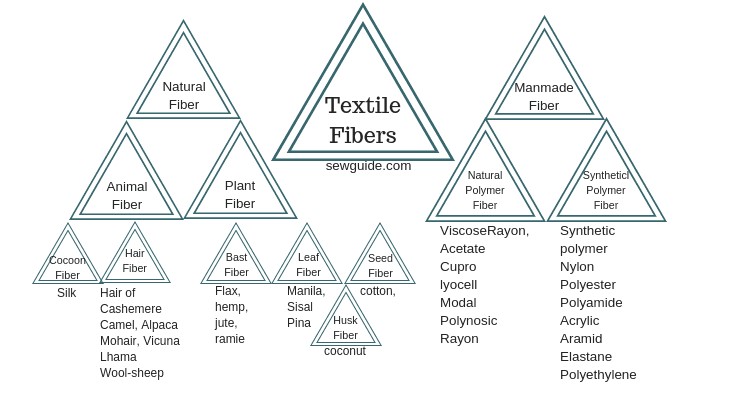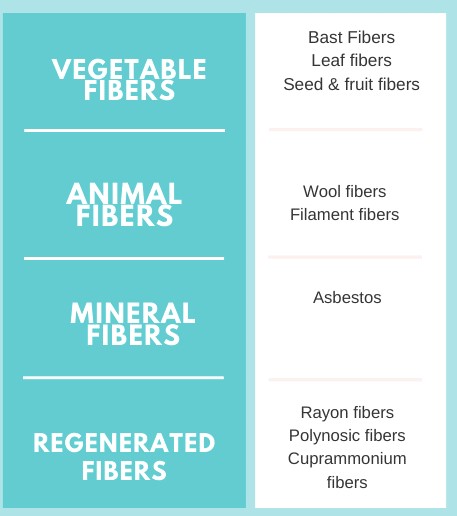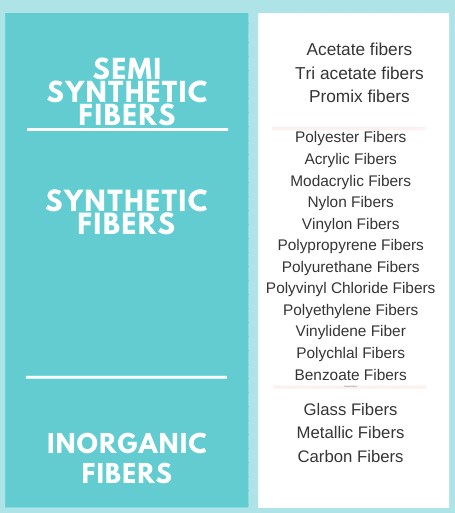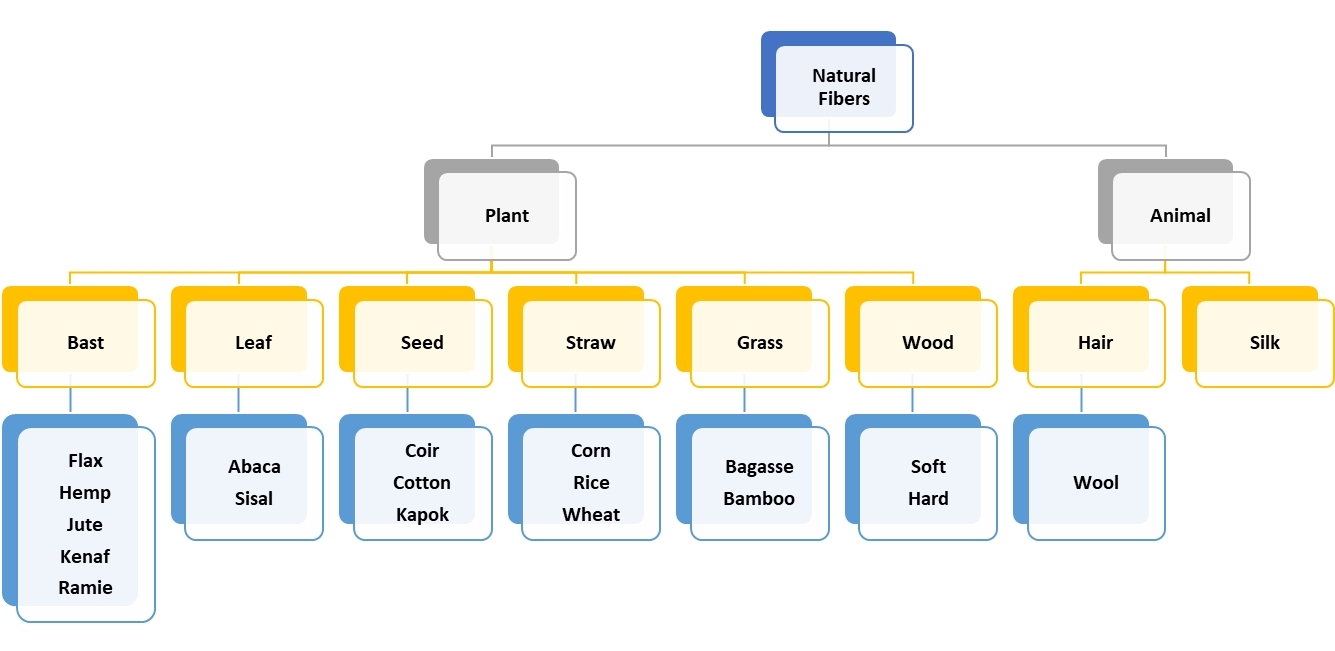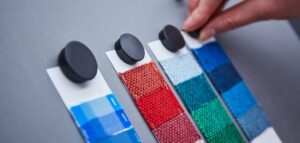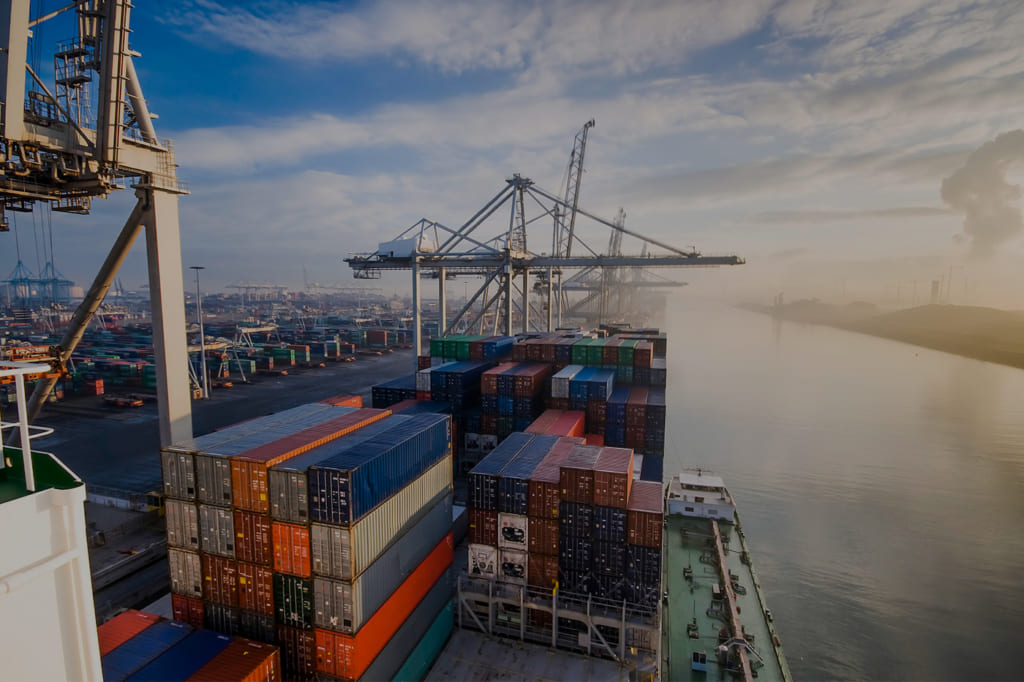Textiles refer to materials made from fibers, thin threads, or filaments that are natural or manufactured or a combination. Textiles are created by interlocking these yarns in specific patterns resulting in a length of cloth.
As per the Federal Trade Commission’s website – The term “fiber” or “textile fiber” means a unit of matter which is capable of being spun into a yarn or made into a fabric by bonding or by interlacing in a variety of methods including weaving, knitting, braiding, felting, twisting, or webbing, and which is the basic structural element of textile products.
The textile fibers are spun into yarn and then made into fabric by different methods like weaving, knitting, felting. It forms the building block of a garment. So many properties of the fiber, like fiber type, yarn gauge, twist yarns per inch, weave float, and how it is processed and finished, determine the final product.
What are textile fibers?
Textile fibers refer to filaments or threads which are woven, knitted, matted or bound to be used to make fabrics for different purposes. To put it in perspective, Fabric is made from yarns and yarn is made from fibers.
Common Natural textile Fibers which are used to make fabrics are Cotton, Silk, Wool, Hemp, Jute, Flax/Linen, Cashmere, Mohair, Alpaca, Angora, Ramie, and Coconut.
Manmade textile Fibers are Polyester, Nylon, Rayon, Acrylic, Spandex/Lycra, Olefin/Polypropylene, Modal
Tencel/Lyocell, Viscose, Bamboo Rayon, Carbon Fiber, and Aramid/Kevlar
Textile fibers are generally classified as natural textile fibers and man-made fibers. As man advanced in textile technology he has discovered a variety of man-made as well as natural fibers which have been a boon to designers looking for different characteristics in the textiles they use to design their creations with.
Natural Fibers
Natural fibers are fibers obtained from plants and animals; they are further classified as Vegetable fibers Animal fibers and Mineral fibers.
They are harvested from plants or by shearing animal fur. The most common ones you must know are wool, silk (from animals) cotton, jute, flax (from plants) .
Hair-bearing animals like silkworms and sheep are shorn of their fur to produce these fibers( wool, silk); Fibers are also extracted from roots, leaves, etc., of plants like cotton, flax, etc. Minerals like asbestos are also used to make fibers.
1. Plant Fibers
Bast Fibers are strong, cellulosic fibers obtained from the outer/inner bark of plants. The most prominent is Jute, hemp (Abaca stalk), flax (Linen), kenaf, rattan, vine fibers and Ramie (Rhea and china grass)
Leaf fibers are Sisal leaf fibers (Agave leaf) and Manila leaf fibers, Pina (Pineapple leaf)
Seed & fruit fibers are cotton, kapok (Capok tree) and coir (Coconut husk).
2. Animal fibers (also called protein fibers)
Hair fibers and wool fibers
Wool is the most popularly used animal fiber; it is obtained from the skin of different breeds of sheep.
The major hair fibers used to make textiles are Mohair, Cashmere, Alpaca, Lhama, Vucna, Kasha, Camel’s hair, Rabbit hair, Horsehair,Chiengora fibre (dog’s hair). Yak’s hair is a favourite for making clothes. Animal hair fibers are generally stiffer than woolen fibers, though some like camel’s hair are soft. Cat’s hair and cows hair are also used.
Silk is an animal fiber obtained as a filament mostly from the silkworm Bombyx mori. Other silkworm breeds, spider, a special kind of seashell also produce different types of silk.
3. Mineral fibers
These are fibers derived from natural mineral sources or are manufactured from inorganic and mineral salts. Asbestos is a mineral fiber (Silicate of Magnesium and Calcium)and cloth made of this fiber is mostly used for industrial purposes
Natural fibers are textile fibers that are original in nature or directly obtained from artificially cultivated plants and animals, which are important sources of material for the textile industry. Alfa Chemistry offers a wide range of natural fiber materials, including plant fibers, animal fibers, chitin and chitosan fibers.
4. Chitin and Chitosan Fibers
Chitin has both the biological functions of collagen in higher animal tissues and fibrin in higher plant tissues, and has become a new material with a wide range of uses. Chitosan is the most important derivative of chitin.
Fiber Modification
As green materials, natural fibers can provide environmentally friendly and sustainable solutions for the next generation of composite products. To meet the growing demand for using environmentally friendly materials in different applications, several modification and processing techniques are being researched and developed.
Physical Modification
Physical modification methods can be used to alter the surface properties of natural fibers. Physical treatment methods include corona, plasma, ultraviolet (UV), fiber beating and heat treatment.
Chemical Modification
The chemical modification methods can achieve by various chemical reactions. Chemical treatments include bases, silanes, acetylation, benzoylation, peroxides, maleated coupling agents, sodium chlorite, acrylation and acrylonitrile grafts, isocyanates, stearic acid, permanganate, triazine, oleoyl chloride and fungal treatments.
Features And Applications
- Textile Industry
It is well known that several natural fibers play an indispensable role in the textile industry, especially cotton, wool, silk, etc. They dominate the scale of production and use of textiles. - Composite Material
Natural fibers are replacing synthetic fibers in composites due to their low cost, low density, high availability, and low tool wear. For renewability and sustainability, natural fibers are widely used as reinforcements. For example, Ramesh et al. developed a sisal-jute-glass fiber reinforced polyester composite with improved impact properties. [1] Summary of the advantages and disadvantages of green composites compared to traditional petrochemical composites [2]
| Advantages | Disadvantages |
|---|---|
| Less expensive | Lower mechanical properties (especially impact strength) |
| Lower weight | Higher moisture absorption |
| Higher flexibility | Lower durability |
| Renewable | Poor fire resistance |
| Biodegradable | Variation in quality |
| Good thermal and sound insulation | Restricted maximum processing temperature |
| Eco-friendly | Poor microbial resistance |
| Nontoxic | Low thermal resistance |
| Lower energy consumption | Demand and supply cycles |
| No residues when incinerated | |
| No skin irritations |
- Biomedical Materials
Natural fibers often show promise as biomaterials in medical applications. For example, chitin can be used as bone filler material for tissue regeneration, drug carrier and excipient, and antineoplastic agent.
Man-made fibers
4. Inorganic fibers
Metallic fibers
Aluminum, silver, gold, stainless steel are also used to make fibers.Metallic fibers are manufactured /man-made fibers with high luster composed of metal, plastic-coated metal or metal-coated plastic. They are used to make fabric as well as decorative yarn
Glass fibers
These are fine translucent man-made fibers with great tensile strength, excellent resistance to heat, and flame retardancy; they are mostly used to make home furnishing rather than clothing
Man-made rubber
This is a combination of man made and synthetic rubber.
5. Regenerated fibers
Regenerated fibers are made from cellulose polymers that occur naturally in plants such as cotton, wool, hemp and flax. Regenerated fibers include those based on cellulose (rayon, acetate, triacetate) and protein-based fibers (azlon).
Regenerated fiber is also known as semi-synthetic fibers or regenerated synthetic fibers made from raw materials with long-chain polymer structures. They are modified and are partially degraded during the chemical processes.
Rayon fibers
Rayon is a manufactured fiber composed of regenerated cellulose fiber, made from wood and related agricultural products. It has the same molecular structure as cellulose. It is also called viscose. Many types and grades of viscose fibers exist. Rayon is today one of the most popular dressmaking fabrics; tops and dresses, skirts – all can be made with rayon fabrics.
Viscose is the most important regenerated cellulose fiber in terms of production volume which is prepared by treatment of cellulose with sodium hydroxide and carbon disulfide. Generally, there are three types of rayon: regular rayon, high wet modulus rayon and high tenacity rayon. It has good properties such as silk-like aesthetic, varied color hues, and easy drape.
These are beautiful silk-like fibers made from cotton linters / wooden pulp (cellulose). The drapeability of rayon fabrics make them a favorite in making clothes. The rayon fibers take dye very well and they have good water absorbency. Rayon fibers are used for clothing ( especially to make women’s clothing) and home furnishing; they are also used to make caps , hats, wet tissue etc .
Regenerated fiber is created by dissolving the cellulose area of plant fiber in chemicals and making it into fiber again (by viscose method). Since it consists of cellulose like cotton and hemp, it is also called “regenerated cellulose fiber.” Regenerated cellulosic fibers are made from cellulose that is extracted from wood pulp, which is then chemically dissolved and extruded as a continuous filament, which can be cut into staple fibers.
Polynosic Fibers
This fiber is very similar to Rayon fibers but the tenacity of this fiber is more than that of rayon.
Cuprammonium rayon fiber
Cuprammonium rayon fibers are made from cellulose dissolved in a cuprammonium solution (copper and ammonia). Fabric made of this fiber is very delicate and thin but of high quality
Cupro rayon fibers are produced by dissolving cellulose in a cuproammonium solution and then regenerating the cellulose by wet spinning. However, cupro rayon is not competitive in the fiber market due to its high production cost.
Lyocell
Originally trademarked in 1982 as Tencel, Lyocell fiber consists of cellulose fiber, made from dissolving pulp and then reconstituting it by dry jet-wet spinning. The fiber is used to make textiles for clothing and other purposes. This fabric feels like soft cotton, and it is used to make everything from dress shirts to towels to underwear. While some garments are made entirely from lyocell, it is more common to see this fiber mixed with other types of fibers like cotton or polyester.
Lyocell rayon fibers are made by dissolving cellulose directly in the solvent N-methylmorpholine-N-oxide (NMMO). Lyocell rayon is a new generation of regenerated cellulose fibers with environmentally friendly processing and improved fiber properties. Lyocell exhibits some unique characteristics such as softness, absorption, wrinkle resistance, strong when dry or wet, and easy maintenence.
Modal
This is a regenerated cellulosic fiber that has found fame in the age of activewear. Breathable and absorbent, this cotton alternative is used to manufacture underwear, pajamas, bathrobes, bedsheets, and more. It has better dimensional stability than other viscose fibers
6. Semi-Synthetic fibers
Acetate fibers
Acetate is a cellulose-derived fiber, not a regenerated cellulose fiber. It is produced by acetylating cellulose using acetic anhydride liquid and a sulfuric acid catalyst. The resulting cellulose acetate was dissolved in acetone and spun into fibers by a dry spinning process.
This is a semi-synthetic polymer, also known as cellulose acetate, used to make textile fabrics for clothing. This is a regenerated cellulosic fiber, made from wood pulp, like viscose, modal, cupro, and lyocell. Acetate fibers are used to make linings, blouses, dresses, wedding and party attire, home furnishings, draperies, upholstery, slipcovers, etc.
This fiber also uses wooden pulp as a raw material, which is then treated with acetic acid. Acetate fibers are beautiful soft shiny fibers which are very strong
Triacetate fibers
These are fibers to which more acetic acid is combined than to acetate fibers
This fiber is made from cellulose triacetate. The difference between acetate fiber and tri-acetate fiber is that triacetate has better heat resistance. Other than that it is very similar to acetate – It is resistent to mold, mildew, and insects.
Azlon fibers
These are manmade/synthetic fibers made from naturally occurring proteins like milk, soy and eggs .
7. Synthetic fibers
Synthetic fibers are made of polymers that do not occur naturally but are produced entirely in the chemical plant or laboratory, almost always from by-products of petroleum or natural gas. Synthetic fibers include acrylic, modacrylic, nylon, olefin, polyester, spandex and vinyon.
Synthetic fibers (man-made fibers) are produced by joining chemical monomers into polymers using a chemical reaction called polymerization. The chemicals used are usually sodium hydroxide and carbon disulfide (derivatives of coal, oil, or natural gas). Synthetic fibers are formed by extruding a fiber-forming material, called spinning dope, through a hole or holes in a shower head-like device called a spinneret. This process is called spinning.
Polyester fibers
Polyester fibers are one of the most used of all synthetic fibers. They are very fine fibers and can be blended with other fibers like cotton and wool to create better fabrics with multiple advantages. They have very unique characteristics like stability, strength, resistance to wrinkling which make them great for dressmaking. You can read more about polyester fabric here
Spandex
Also known as Lycra or elastane, spandex is a synthetic fiber characterized by its superior elasticity. Spandex fabrics are mostly used in garments where comfort and fit are required, like hosiery, swimsuits, exercise wear, etc.
Nylon fibers
This is one of the strongest of all textile fibers with qualities like resistance to abrasion, ease of maintenance, resistance to wrinkling, resistance to chemicals. Nylon fibers are used to make all kinds of clothing but it is especially used in making sportswear and lingerie.
This is considered a lightweight fiber. It’s added at the points of wear such as seats of jeans, knees, heels of socks, and toes. Once wet, nylon will lose it’s strength.
Polyurethane fibers
You will know these fibers by the name spandex. They are very stretchable fibers. Garments are made by blending the polyurethane fibers with other fibers; they are used to make swimwear, lingerie etc
Read more: https://vnpolyfiber.com/polymer-fiber/
Acrylic fibers
This is a textile fiber made from Acrylic a plastic component (85% acrylonitrile). The fiber is very soft, lightweight and very close to the characteristics of wool. The quality of warmth retention makes it a favorite fiber to make fabric for sweaters and other winter wear. Moda acrylic is a superior kind of acrylic fiber. One disadvantage of acrylic fiber is that it does not absorb moisture
Moda-acrylic fiber
This fiber is very similar in composition to acrylic fibers but with better heat sensitivity.
Microfiber
This is a synthetic fiber that consists of polyester and polyamide. Microfiber is a durable, soft, and absorbent material, making it perfect for a variety of uses. Because of the way it is made, microfiber is excellent for cleaning, apparel, furniture, and even sports gear. The fibers have been split into very fine strands that are porous and dry quickly. The polyester provides the structure of a towel, while the polyamide adds density and absorption
Olefin fibers
Olefin fiber is a very strong abrasion and stain resistant and colour fast synthetic fiber.It is a popular fiber for making fabrics for Activewear and sportswear
Advantages of Synthetic Fibers
Synthetic fibers are usually more preferred than natural fibers due to their distinct characteristics, such as high strength and low cost, etc. A major part of the textile industry uses Synthetic fibers in the twenty-first century because of their various advantages. These include low cost, higher strength, high manufacturing profits, etc. Some advantages of Synthetic fibers are described as follows:
• High strength: Synthetic fibers are strong and can easily carry heavy things without breaking. This is not true of all Synthetic fibers. Regenerated fibers can be weak.
• Retains their original shape: Synthetic fibers retain their original shape so they can be easily washed and worn.
• They are elastic in nature.
• They are generally soft and are used for clothing purposes.
• Synthetic fibers are generally cheaper compared to natural fibers.
• A variety of colours can be easily incorporated into Synthetic fibers during their production.
• They are lightweight materials.
• Easy manufacturing: Natural fibers undergo long processes while Synthetic fibers can be produced in factories in lesser time.
Disadvantages of Synthetic Fibers
• Lack of absorbency
Some Synthetic fibers (synthetic) do not absorb moisture and trap heat in our bodies.
• Allergic reactions
Some Synthetic fibers cause skin allergies.
• Lack of breathability
Some Synthetic fibers fail to absorb the moisture, sweat, and subsequently, the wearer feels discomfort in hot climates.Many manufactured fibers do not allow air to circulate through them, which can make them uncomfortable to wear, especially in hot and humid conditions.
• Static electricity
Synthetic fibers can generate static electricity, which can be uncomfortable and cause garments to cling to the body.
• Durability
A lot of Synthetic fabrics are top quality – a lot of them pill, and get wear and tear fast. The look of a lot of fabrics can degrade very fast. They also melt in high temperature.
• Environmental impact
Many toxic chemicals are used in the manufacture of these fabrics. And then, these are not easily biodegradable. They remain for years and years causing burden on earth.
Classification of specialty fibers in textile industry
Specialty fibers are chemical fibers with unique physical and chemical structures or specialized functions for certain applications. These fibers can be categorized into corrosion-resistant, high-temperature-resistant, flame-retardant, high-strength, functional, and elastomer fibers based on their performance characteristics.
Corrosion-resistant fibers, such as fluorine-containing fibers, are designed to resist corrosive environments like aqua regia. Common examples include polytetrafluoroethylene and polyvinylidene fluoride fibers, which offer exceptional resistance to various chemicals.
High-temperature-resistant fibers can withstand temperatures ranging from 200 to 230 degrees Celsius without losing their mechanical properties. Polymetaphenylene isophthalamide fiber, known as aramid-1313, is a key heat-resistant fiber with a melting point of 400 degrees Celsius.
Ultra-high molecular weight polyethylene fibers are utilized for applications requiring exceptional strength, such as body armor. These fibers are produced through a special spinning and stretching process to align the macromolecules for increased strength and modulus.
Carbon fiber, composed of carbon content exceeding 90%, is a crucial material in aerospace equipment due to its high strength and modulus. The production process involves pre-oxidizing, carbonizing, and graphitizing raw fibers under specific conditions to achieve the desired carbon content.
Functional fibers, like optical fibers, are designed to guide light and conduct electricity. Optical fibers are constructed using transparent materials with different refractive indexes to enable light transmission for applications in optical communication, data transmission, lighting, and digital displays in various industries.
How are textiles made ?
After the fibers are produced, they are made into yarn. Different types of fibers undergo different types of spinning processes to make them into yarns. The finished yarn is made into fabric by different methods like weaving & knitting. Other methods like crocheting, felting, laminating, knotting etc are also used.
Production of textiles is woven into the history of their respective regions. Each textile tells a specific original story of the people who made and used them down the centuries. Some of these textiles are no longer in use, or they have lost their commercial importance for several reasons.
Man has since invented many processes and technologies to produce beautiful textiles with spectacular designs and patterns in the most cost-effective and streamlined ways.
Mass production of textiles with minimum dependence on manual labour has cut down the production cost of textiles and has made most of the textiles affordable for ordinary people like you and me.
Knitting -This is a process in which loops of fibers are interlocked to form the fabric. Weft knitting involves forming of loops one at a time in a weftways direction. Eg. Purl knit, Interlock, Rib knit.
Warp knitting involves a set of arp yarns which are simultaneously formed into loops. These loops are interlinked by connecting the chains of loops with warp thread which are moved sideways.
Felting – This is a process which makes use of heat, pressure and moisture and adhesives to interlock fibers to produce the fabric
Weaving – This is a process in which warp fibers (threads that is lying along the length of the fabric) and weft fibers (threads that are lying along the width of the fabric) are interlaced to form the fabric.
Non woven methods – The fabric is made directly without knitting or weaving with the fibers held together with gum, resin, heat, and pressure, or needle punching. The processes include Felted, Spun-Bonded, Film Tufted, Needle-punched, Spun-Laced Foam, and Stitch-Bonded.
Braiding – Fibers are twisted and braided – some trimmings are made this way.
Knotting and interlacing – Fibers are knotted at intersections, interlaced, and interloped to form an open mesh fabric. Lace is an openwork fabric made by looping, plaiting, or twisting thread by means of a needle or a set of bobbins; this includes fabrics made by crochet. Fishing nets, macrame etc. are other examples.
Type of Weave:
Plain weave textiles eg : Most fabrics Muslin, broadcloth, Canvas ( In this type of woven textiles the weft yarn is alternately passed over one warp yarn and under the next yarn perpendicular to each other).
Satin weave textiles Eg: Satin. (Woven Textiles with a smooth finish on one side and a matt finish on the other side due to the weaving that makes either weft or warp thread dominate the weaving structure.)
Twill weave textiles Eg. Denim (Woven Textiles made in a special weaving pattern that produces a diagonal weave / ridges throughout the fabric);
Basket weave, rib weave, dobby weave, jacquard weave, herringbone weave etc are other types of classifications.
Single cloth or Double cloth
According to the way the fabric is woven the textiles are further categorized as single cloth or double cloth.
The single cloth is made when one yarn of warp and one yarn of weft are interlaced. In this type, there may be a balance of weft and warp yarns or an imbalance. When there is a balance and the weft and warp yarns are of equal thickness, the textile is called an ordinary structure. But where there is a prominence of a yarn this is called a rib structure. There may be warp rib structure with weft yarn stronger and a warp surface rib is formed.
In some textiles, extra threads (warp or weft) are stitched on the back of the fabric for weight – (this is not visible from the front). This is called a backed cloth.
A double cloth will have two warp and two weft yarns interlacing resulting in a much stronger textile with more weight. Sometimes the double cloth is separated as in the case of velvet.
Types of Knits
Tricot Knits (A warp knit textile which is very soft and stretchy; Used to make lingerie)
Raschel Knits (Another warp knit fabric with a complex structure; it almost looks like lace or crochet)
Jersey Knits (The most basic weft knit textile which is more stretchy than warp knits; sweaters, lingerie are all made in this knit)
Double Knits (A weft knit textile made with 2 different yarn feeds interlocking), Interlock knits, Purl Knits, Rib Knits, Float Jacquard knits ( with a pattern on the face of the fabric) Full Jacquard knits (with pattern on both sides) are all weft knit textiles.
Uses of Textile:
Apparel textiles, which include fabric used for making fashion wear, household textiles which include Table linen, bed sheets, towelling etc;
Industrial Textiles, used for making filters, medical textiles, geo textile etc;
Consumer textiles which include fabric for making sleeping bags, bags
Floor coverings
Furnishing textiles includes that are used for curtains, upholstery, wall coverings etc
Applications of fibers:
- Textile Industry
Viscose rayon fibers are used in a wide range of apparel applications, bringing unique drape, softness and hygroscopicity to formal and casual apparel products. - Biocomposite
The advancement in biotechnology led to the production of regenerated silk fibers. The wood based regenerated fibers have been used to produce fiber reinforced composites while regenerated silk fibers were used for biomedical applications such as scaffolds. - Water Sensor
H. Orelma et al. used regenerated cellulose and cellulose acetate to prepare optical cellulose fibers for water sensor applications. The prepared optical fibers guide light in the range of 500-1400 nm. The decay constant of cellulose fibers was observed to be 6.3 dB/cm at 1300 nm.
Textitle Glossary:
- Count of cloth – The number of ends and picks per inch in a woven fabric.
- Thread count – The total number of warps and wefts per square inch of a woven fabric. This is an indicator of the quality of a textile
- Ply – This refers to the number of threads used to form a yarn used to weave the fabric – it indicates the weight of yarn. Larger the ply, heavier the fabric.
- Selvedge (Selvage) – The two long finished edges, one on
each side along the length of the fabric - Sley – The number of warp ends per inch in a fabric exclusive of selvage. A fabric of high sley has a high number of warp yarns per inch.
- Textile Finishes – This is a general term which refers to the treatment of a fabric to add a functional or decorative quality to it
- Tear Strength – The force necessary to tear a fabric. This is usually expressed in pounds or in grams.
- Yarn – The continuous strand of fiber or group of fibers used in weaving knitting etc forming the fabric
- Warp yarn – Lengthwise yarn in a woven textile
- Weft Yarn – Crosswise yarn in a woven textile (also called pickings or filling yarn). They are interlaced with warps in a crosswise direction to make a fabric.
- Warp-faced textile – Fabric which has prominent warp yarns on the surface
- Weft-faced textile – Fabric with prominent weft yarns on the surface
- Zephyr – Lightweight fabrics
Read more:
https://vnpolyfiber.com/classification-of-textile-fibers/
https://vnpolyfiber.com/all-about-synthetic-fibers-and-fabrics/
https://vnpolyfiber.com/synthetic-fibers-vs-man-made-fibers-definitions-and-classifications/
https://vnpolyfiber.com/what-is-natural-fibers/
https://vnpolyfiber.com/all-about-fibers-definition-types-and-applications/

